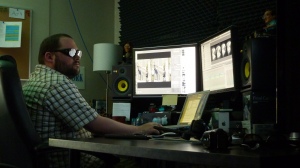Shooting a 3D documentary: building a mini beam splitter rig for close ups
Vision alert. So we’re thinking of designing our own mini beam splitter rig to shoot close ups for our first 3D documentary . Here’s why: as I’ve mentioned,we’re trying to sort out our B cam system using Film Factory’s 3D Indie BS Rig – this should hopefully work for the majority of our B cam shots.
But it isn’t the most portable system – something that will surely prove challenging on an industrial site, where the explosive demolition series Blowdown takes place.
For the odd close up of the crew loading explosives etc. in a condemned sports stadium in Salvador, Brazil, it’s painful to think about moving the whole rig and setting up just to get a shot or two.
And we’d like to avoid using a side-by-side rig because it’s a mission (if not a mission impossible) to get the cameras close enough together to film these types of shots.
If there’s a way to build a mini beam splitter unit, one person could just move in and get this footage with way less trouble (ie. instead of two people to set up the full-sized rig, etc.).
As an added bonus, we could also use this system in a temporary pinch if the main B cam system happened to go down.
We bought an extra mirror anyway, in case the one that came with the Film Factory Indie rig system malfunctions mid-shoot … why not try and put it to use?
Our stereographer, Sean White, knows a machinist who may be able to help us build this mini rig we’ve envisioned.
We’d probably use Canon Vixias – smaller than the Sony EX1/EX3 combination we’re trying to make work with the Film Factory Indie rig – and rig it as an underslung system.
One camera would be positioned below (instead of above), and the spare mirror would be angled the opposite way as the one on the full-fledged beam splitter rig.
This rig would theoretically snap onto a tripod, and would achieve a small enough interaxial distance for us to get the close-ups we need without a mega hassle.
If any stereo, etc. issues arose, we’d correct them in post – theoretically a relatively small workload considering we don’t use tons of these types of shots in our shows.
At the moment, it’s just an idea – but seems fittingly par for this unchartered course.


